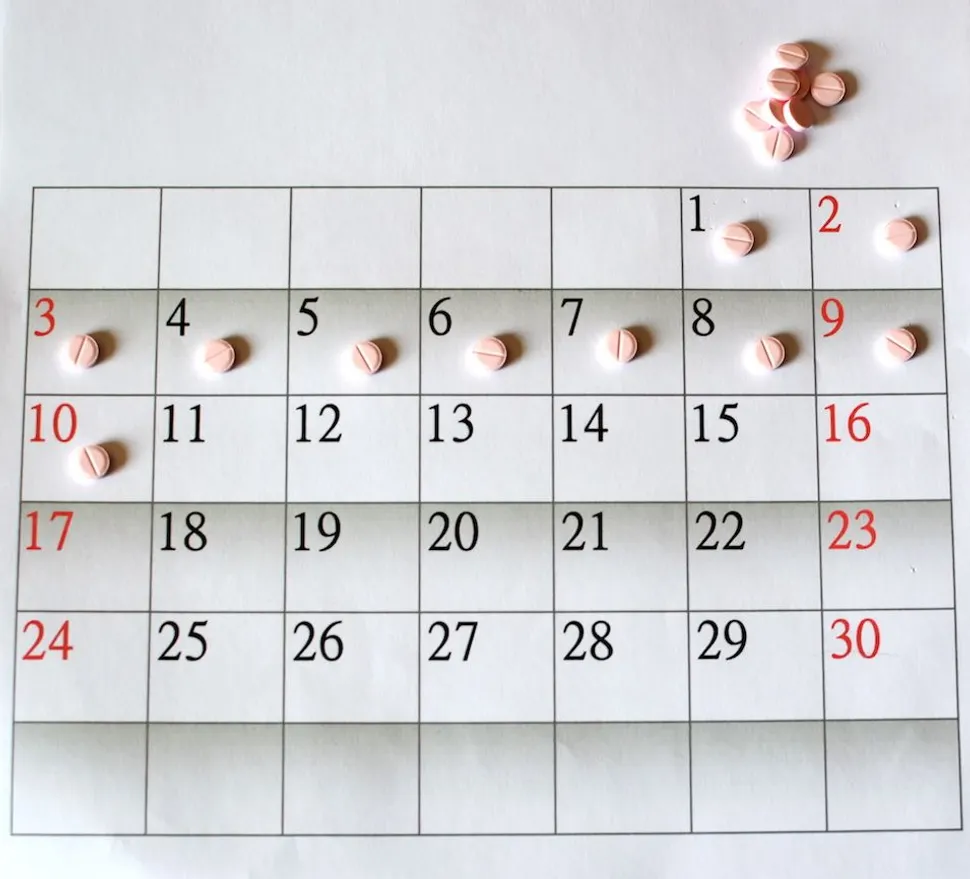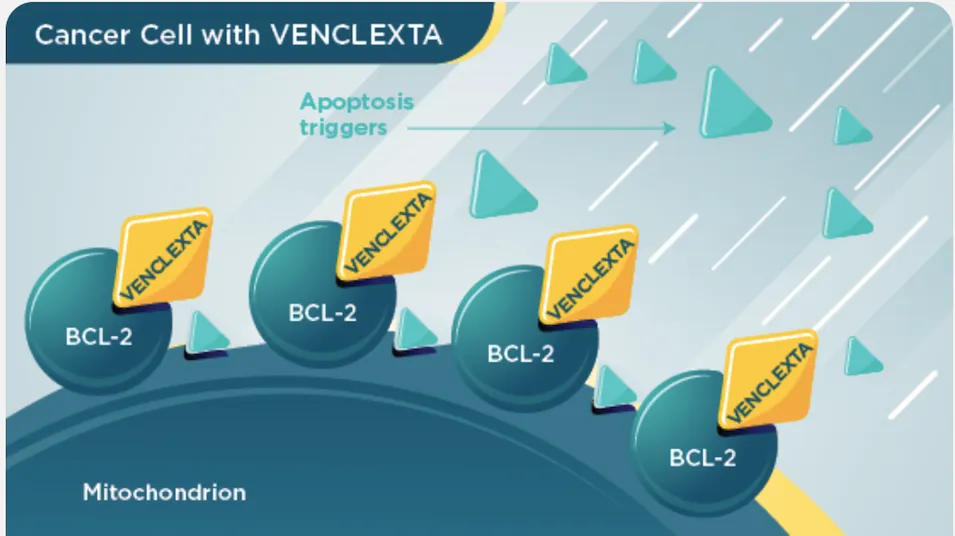Non-Chemo Venetoclax: An End Date for CLL Treatment

What is Venetoclax?
Venetoclax (VENCLEXTA) created by AbbVie is an FDA-approved non-chemo targeted therapy for CLL. It is taken via tablets by mouth and is often combined with a non-chemo antibody treatment for a fixed period of time (~12 months for previously untreated CLL and ~24 months for previously treated CLL). It targets and kills mainly CLL cancer cells by blocking the BCL-2 protein, which regulates cell survival and death. Overproduction of BCL-2 is common in CLL cancer cells, and blocking it with venetoclax causes the cancer cells to die.
“It really appealed to me that with venetoclax there is an end date to treatment. I went from this place of being concerned to being hopeful” (John, a CLL patient).
(Image: VENCLEXTA How it Works)
Antibody Treatments + Venetoclax
Treating CLL using a combination of a non-chemo antibody treatment and venetoclax has proven more effective than using venetoclax alone.
Monoclonal antibody treatments like obinutuzumab and rituximab kill the CLL cancer cell by binding to the CD20 protein on the surface of the cell signaling the body's immune system to target and destroy the cancer cell.
Clinical Trial Results: Venetoclax + Obinutuzumab for Previously-untreated CLL
A study of 432 previously-untreated CLL patients found that venetoclax combined with non-chemo antibody treatment obinutuzumab (GAZYVA) was more effective than the chemotherapy-containing regimen of chlorambucil + obinutuzumab. The chance of disease worsening or death (progression-free survival [PFS]) was 67% lower with the venetoclax regimen than with the chemotherapy-containing regimen.
- 85% of participants achieved remission with venetoclax + obinutuzumab compared to 71% with chlorambucil + obinutuzumab
- Remission is a term used to describe the reduction or disappearance of cancer signs and symptoms
- 50% of people achieved complete remission or complete remission with incomplete marrow recovery with venetoclax + obinutuzumab compared to 23% with chlorambucil + obinutuzumab
- Complete remission means all signs and symptoms have disappeared temporarily, but cancer may still be present
- Complete remission with incomplete marrow recovery means most signs and symptoms have disappeared, but blood cell counts remain low
- 35% achieved partial remission with venetoclax + obinutuzumab compared to 48% with chlorambucil + obinutuzumab
- Partial remission means that while cancer signs are still present, treatment is working as the number of cancer cells have decreased
- 76% achieved MRD negativity in their blood (measured 3 months after treatment) with venetoclax + obinutuzumab compared to 35% with chlorambucil + obinutuzumab
- Minimal residual disease negativity (MRD negativity) means that the cancer cells are not detectable using sensitive clinical tests [fewer than 1 cancer cell per 10,000 white blood cells]
Clinical Trial Results: Venetoclax + Rituximab for Previously Treated CLL
A study of 389 previously treated CLL patients found that venetoclax combined with non-chemo antibody treatment rituximab was more effective than the chemotherapy-containing regimen of bendamustine + rituximab. The chance of disease worsening or death (progression-free survival [PFS]) was 81% lower with the venetoclax regimen than with the chemotherapy-containing regimen.
- 92% achieved remission with venetoclax + rituximab compared to 72% with bendamustine + rituximab
- 8% of people achieved complete remission or complete remission with incomplete marrow recovery with venetoclax + rituximab compared to 4% with bendamustine + rituximab
- 82% achieved partial remission with venetoclax + rituximab compared to 68% with bendamustine + rituximab
- 54% achieved MRD negativity in their blood (measured 3 months after treatment) with venetoclax + rituximab compared to 12% with bendamustine + rituximab
Side Effects
Common side effects of venetoclax alone or with antibody treatment include:
- Low blood cell count (white blood cell, platelet, and/or red blood cell)
- Diarrhea
- Nausea
- Upper respiratory tract infection
- Cough
- Muscle and joint pain
- Tiredness
- Swelling of arms, legs, hands, and/or feet
Rare but serious side effect:
- Tumor lysis syndrome (TLS) is a rare side effect of venetoclax caused by the fast breakdown of cancer cells. In the clinical trials, all cases of patients with TLS were resolved and did not lead to withdrawal from the study. The percentage of patients that experienced TLS was 1% treated with venetoclax + obinutuzumab and 3% treated with venetoclax + rituximab. If left unresolved, TLS may cause kidney failure, the need for dialysis treatment, or death. Tell your doctor right away if you experience symptoms associated with TLS including: fever, chills, vomiting, confusion, shortness of breath, seizures, dark or cloudy urine, or irregular heartbeat.
Managing Side Effects
Notify your CLL specialist about any side effects you may be experiencing. HealthTree's Side Effect Solutions tool is also available for patients to find and contribute solutions to common CLL related side effects.
(Sources: VENCLEXTA Previously-untreated CLL, VENCLEXTA Previously Treated CLL)
What is Venetoclax?
Venetoclax (VENCLEXTA) created by AbbVie is an FDA-approved non-chemo targeted therapy for CLL. It is taken via tablets by mouth and is often combined with a non-chemo antibody treatment for a fixed period of time (~12 months for previously untreated CLL and ~24 months for previously treated CLL). It targets and kills mainly CLL cancer cells by blocking the BCL-2 protein, which regulates cell survival and death. Overproduction of BCL-2 is common in CLL cancer cells, and blocking it with venetoclax causes the cancer cells to die.
“It really appealed to me that with venetoclax there is an end date to treatment. I went from this place of being concerned to being hopeful” (John, a CLL patient).
(Image: VENCLEXTA How it Works)
Antibody Treatments + Venetoclax
Treating CLL using a combination of a non-chemo antibody treatment and venetoclax has proven more effective than using venetoclax alone.
Monoclonal antibody treatments like obinutuzumab and rituximab kill the CLL cancer cell by binding to the CD20 protein on the surface of the cell signaling the body's immune system to target and destroy the cancer cell.
Clinical Trial Results: Venetoclax + Obinutuzumab for Previously-untreated CLL
A study of 432 previously-untreated CLL patients found that venetoclax combined with non-chemo antibody treatment obinutuzumab (GAZYVA) was more effective than the chemotherapy-containing regimen of chlorambucil + obinutuzumab. The chance of disease worsening or death (progression-free survival [PFS]) was 67% lower with the venetoclax regimen than with the chemotherapy-containing regimen.
- 85% of participants achieved remission with venetoclax + obinutuzumab compared to 71% with chlorambucil + obinutuzumab
- Remission is a term used to describe the reduction or disappearance of cancer signs and symptoms
- 50% of people achieved complete remission or complete remission with incomplete marrow recovery with venetoclax + obinutuzumab compared to 23% with chlorambucil + obinutuzumab
- Complete remission means all signs and symptoms have disappeared temporarily, but cancer may still be present
- Complete remission with incomplete marrow recovery means most signs and symptoms have disappeared, but blood cell counts remain low
- 35% achieved partial remission with venetoclax + obinutuzumab compared to 48% with chlorambucil + obinutuzumab
- Partial remission means that while cancer signs are still present, treatment is working as the number of cancer cells have decreased
- 76% achieved MRD negativity in their blood (measured 3 months after treatment) with venetoclax + obinutuzumab compared to 35% with chlorambucil + obinutuzumab
- Minimal residual disease negativity (MRD negativity) means that the cancer cells are not detectable using sensitive clinical tests [fewer than 1 cancer cell per 10,000 white blood cells]
Clinical Trial Results: Venetoclax + Rituximab for Previously Treated CLL
A study of 389 previously treated CLL patients found that venetoclax combined with non-chemo antibody treatment rituximab was more effective than the chemotherapy-containing regimen of bendamustine + rituximab. The chance of disease worsening or death (progression-free survival [PFS]) was 81% lower with the venetoclax regimen than with the chemotherapy-containing regimen.
- 92% achieved remission with venetoclax + rituximab compared to 72% with bendamustine + rituximab
- 8% of people achieved complete remission or complete remission with incomplete marrow recovery with venetoclax + rituximab compared to 4% with bendamustine + rituximab
- 82% achieved partial remission with venetoclax + rituximab compared to 68% with bendamustine + rituximab
- 54% achieved MRD negativity in their blood (measured 3 months after treatment) with venetoclax + rituximab compared to 12% with bendamustine + rituximab
Side Effects
Common side effects of venetoclax alone or with antibody treatment include:
- Low blood cell count (white blood cell, platelet, and/or red blood cell)
- Diarrhea
- Nausea
- Upper respiratory tract infection
- Cough
- Muscle and joint pain
- Tiredness
- Swelling of arms, legs, hands, and/or feet
Rare but serious side effect:
- Tumor lysis syndrome (TLS) is a rare side effect of venetoclax caused by the fast breakdown of cancer cells. In the clinical trials, all cases of patients with TLS were resolved and did not lead to withdrawal from the study. The percentage of patients that experienced TLS was 1% treated with venetoclax + obinutuzumab and 3% treated with venetoclax + rituximab. If left unresolved, TLS may cause kidney failure, the need for dialysis treatment, or death. Tell your doctor right away if you experience symptoms associated with TLS including: fever, chills, vomiting, confusion, shortness of breath, seizures, dark or cloudy urine, or irregular heartbeat.
Managing Side Effects
Notify your CLL specialist about any side effects you may be experiencing. HealthTree's Side Effect Solutions tool is also available for patients to find and contribute solutions to common CLL related side effects.
(Sources: VENCLEXTA Previously-untreated CLL, VENCLEXTA Previously Treated CLL)

about the author
Megan Heaps
Megan joined HealthTree in 2022. She enjoys helping patients and their care partners understand the various aspects of the cancer. This understanding enables them to better advocate for themselves and improve their treatment outcomes.
More on Navigating Your Health
Trending Articles

Get the Latest Chronic Lymphocytic Leukemia Updates, Delivered to You.
By subscribing to the HealthTree newsletter, you'll receive the latest research, treatment updates, and expert insights to help you navigate your health.
Together we care.
Together we cure.
3x Faster.









